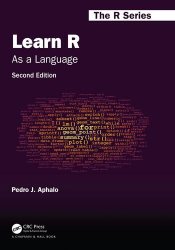Learn R: As a Language, 2nd Edition
- Добавил: literator
- Дата: 8-04-2024, 20:16
- Комментариев: 0
 Название: Learn R: As a Language, 2nd Edition
Название: Learn R: As a Language, 2nd EditionАвтор: Pedro J. Aphalo
Издательство: CRC Press
Серия: The R Series
Год: 2024
Страниц: 466
Язык: английский
Формат: pdf (true)
Размер: 11.2 MB
Learning a computer language like R can be either frustrating, fun or boring. Having fun requires challenges that wake up the learner’s curiosity but also provide an emotional reward for overcoming them. The book is designed so that it includes smaller and bigger challenges, in what I call playgrounds, in the hope that all readers will enjoy their path to R fluency. Fluency in the use of a language is a skill that is acquired through practice and exploration. For students and professionals in the biological sciences, humanities and many applied fields, recognizing the parallels between R and natural languages should help them feel at home with R. The approach I use is similar to that of a travel guide, encouraging exploration and describing the available alternatives and how to reach them. The intention is to guide the reader through the R landscape of 2024 and beyond.
In R, like in most “rich” languages, there are multiple ways of coding the same operations. I have included code examples that aim to strike a balance between execution speed and readability. One could write equivalent R books using substantially different code examples. Keep this in mind when reading the book and using R. Keep also in mind that it is impossible to remember everything about R, and as a user you will frequently need to consult the documentation, even while doing the exercises in this book. The R language, in a broad sense, is vast because it can be expanded with independently developed packages. Learning to use R mainly consists of learning the basics plus developing the skill of finding your way in R, its documentation and on-line question-and-answer forums.
Readers should not aim to remember all the details presented in the book. This is impossible for most of us. Later use of this and other books, and documentation effectively as references, depends on a good grasp of a broad picture of how R works and on learning how to navigate the documentation; i.e., it is more important to remember abstractions and in what situations they are used, and function names, than the details of how to use them. Developing a sense of when one needs to be careful not to fall into a “language trap” is also important.
The book can be used both as a textbook for learning R and as a reference. It starts with simple concepts and language elements progressing towards more complex language structures and uses. Along the way readers will find, in each chapter, descriptions and examples of the common (usual) cases and the exceptions. Some books hide the exceptions and counterintuitive features from learners to make the learning easier; I instead have included these but marked them using icons and marginal bars. There are two reasons for choosing this approach. First, the boundary between boringly easy and frustratingly challenging is different for each of us, and varies depending on the subject dealt with. So, I hope the marks will help readers predict what to expect, how much effort to put into each section, and even what to read and what to skip. Second, if I had hidden the tricky bits of the R language, I would have made later use of R by the readers more difficult. It would have also made the book less useful as a reference.
The book contains many code examples as well as exercises. I expect readers
will run code examples and try as many variations of them as needed to develop
an understanding of the “rules” of the R language, e.g., how the function or feature
exemplified works. This is what long-time users of R do when facing an unfamiliar
feature or a gap in their understanding.
What is new in the second edition?
Text expanded by more than 25% to include additional R features and gentler and more detailed explanations
Contains 24 new diagrams and flowcharts, seven new tables, and revised text and code examples for clarity
All three indexes were expanded, and answers to 28 frequently asked questions added
What will you find in this book?
Programming concepts explained as they apply to current R
Emphasis on the role of abstractions in programming
Few prescriptive rules—mostly the author’s preferences together with alternatives
Presentation of the R language emphasizing the “R way of doing things”
Tutoring for “programming in the small” using scripts for data analysis
Explanation of the differences between R proper and extensions for data wrangling
The grammar of graphics is described as a language for the construction of data visualisations
Examples of data exchange between R and the foreign world using common file formats
Скачать Learn R: As a Language, 2nd Edition
[related-news] [/related-news]
Внимание
Уважаемый посетитель, Вы зашли на сайт как незарегистрированный пользователь.
Мы рекомендуем Вам зарегистрироваться либо войти на сайт под своим именем.
Уважаемый посетитель, Вы зашли на сайт как незарегистрированный пользователь.
Мы рекомендуем Вам зарегистрироваться либо войти на сайт под своим именем.
